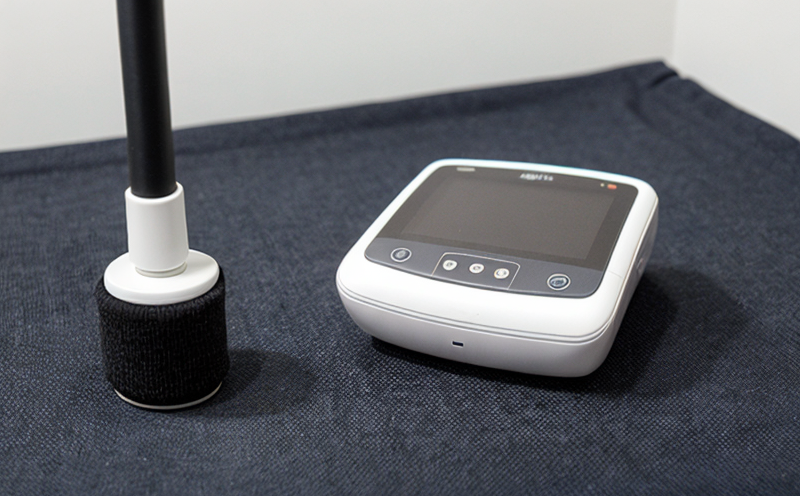ASTM D257 Measurement of DC resistance of electronic fabrics
The ASTM D257 standard provides a method to measure the direct current (DC) resistance of electronic fabrics. This test is critical for ensuring that the electrical properties of materials used in textiles meet safety and performance requirements, particularly when these materials are intended to function as components in electronic circuits.
This testing procedure is essential in various sectors including aerospace, automotive, consumer electronics, and medical devices where high reliability and minimal resistance are paramount. In aerospace applications, for instance, the reduced weight of fabrics used can significantly impact fuel efficiency. Similarly, in electronics, minimizing resistance helps to prevent overheating and potential fire hazards.
The test involves placing a specimen between two electrodes through which a DC current is passed. The voltage across the specimen is measured simultaneously, allowing for the calculation of resistance using Ohm's law (R = V/I). Specimens must be prepared according to ASTM D257 specifications, ensuring that they are cut from the same batch and lot as those used in production.
The apparatus required includes a low-voltage DC source capable of providing a current of 1 milliampere or less, an ammeter with a range suitable for the expected resistance values (usually between 0.1 ohm and 100 megohms), a voltmeter, and insulated leads.
When conducting this test, it's crucial to account for factors like temperature since resistivity is temperature-dependent. Specimens should be conditioned at a standard laboratory temperature of 23 ± 2°C (73.4 ± 3.6°F) before testing begins. This ensures that the measured resistance accurately reflects the material’s intrinsic properties under specified conditions.
ASTM D257 specifies acceptance criteria based on the expected performance characteristics of the fabric. For example, if a product is designed to have minimal DC resistance for efficient electrical conductivity, any specimen exceeding this threshold would fail the test and must be reworked or rejected.
The results from ASTM D257 testing play a pivotal role in quality assurance processes by helping companies ensure their products meet stringent regulatory standards. They also contribute to R&D efforts aimed at developing new materials with enhanced electrical properties, such as those used in wearable tech garments that monitor physiological parameters like heart rate or skin temperature.
Compliance officers rely on these tests to verify that their suppliers are meeting contractual obligations related to material specifications. By using ASTM D257, they can guarantee consistent quality across batches and lots of production runs, thereby reducing the risk of product recalls due to faulty components.
In summary, ASTM D257 is a vital tool in ensuring safe and reliable electronic fabrics used in diverse industries ranging from consumer electronics to aviation. Its application not only enhances product performance but also contributes significantly to occupational safety by preventing hazards associated with high resistance materials.
Applied Standards
| Standard Number | Description |
|---|---|
| ASTM D257-18 | Standard Test Method for DC Resistance and AC Inductive Impedance of Electrical Insulation at Room Temperature. |
| ISO 10396 | Electrical resistance of textile materials – Determination of DC resistance using a two-point method. |
| IEC 60287 | Determination of the direct current (DC) resistance of electrically conductive yarns and fabrics. |
The ASTM D257-18 standard is widely recognized for its accuracy and reliability in measuring DC resistance. It complements other international standards such as ISO 10396, which focuses on the two-point method of determining resistivity, and IEC 60287, which deals specifically with conductive yarns and fabrics.
These standards ensure that manufacturers adhere to globally accepted benchmarks for material performance. By aligning their testing protocols with these recognized guidelines, companies can gain confidence in the quality of their products while also facilitating easier compliance with international regulations.
Why Choose This Test
The ASTM D257 test is chosen for its precision and repeatability. Its standardized procedures provide consistent results, which are essential for quality control in manufacturing environments where batch-to-batch variations could lead to significant inconsistencies in product performance.
Moreover, this testing method allows manufacturers to identify potential issues early in the production process. By detecting deviations from expected resistance levels during development stages, companies can address these concerns before large-scale production begins, thus saving time and resources that would otherwise be spent addressing defects post-production.
Achieving compliance with ASTM D257 not only ensures adherence to industry standards but also enhances brand reputation among customers who value safety and reliability. In today’s competitive market, demonstrating a commitment to high-quality testing can differentiate brands from competitors offering similar products at lower prices or without comparable quality assurance measures in place.
From an environmental perspective, ensuring that electronic fabrics meet stringent resistance requirements helps reduce waste by improving product longevity. When components perform optimally due to proper material selection and testing, there’s less likelihood of premature failure leading to replacement needs sooner than necessary.





